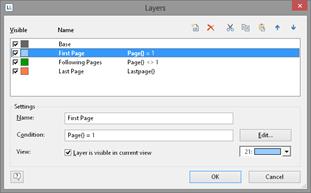You define layers via Project > Layers (Project > Layer Definitions) or by double clicking in the "Layers" tool window.
In the "Layers" dialog, you can define as many additional layers as you want with the "New" or "Copy/Insert" buttons. Each new layer appears initially with the name "Layer". You can enter a meaningful name for the layer in the "Name" field.
§ When creating new projects, the "Base", "First page" and "Following pages" layers are automatically defined.
§ It's a good idea to give the layers different colors in order to easily tell them apart. This also causes the objects in the respective layers to be shown in different colors in the layout preview display mode. This color has no effect on the actual print.
§ If you delete a layer, the associated objects are automatically assigned to the base layer. At least one layer must be defined.
§ New objects are automatically assigned to the first visible layer.
§ The Lastpage() function in an appearance condition can only be evaluated correctly if an object is linked to a table/report container.
§ User variables cannot be used within appearance conditions of layers.

Figure 4.2: Layer definition dialog
In the "Condition" field you define the appearance condition for this layer. This appearance condition then applies for all objects on the layer in question, i.e. the associated objects are only printed when the condition for the layer is met.
Typical appearance conditions:
Condition |
Explanation |
no condition |
The objects on this layer are always printed. |
Page()=1 |
The objects on this layer are only printed on the first page. |
Page()<>1 |
The objects on this layer are printed from the second page onwards. |